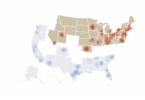How Old Are You Now?
The United States is not prepared to meet the housing needs of aging Americans, according to a new report by the Harvard Joint Center for Housing Studies and the AARP Foundation. The number of Americans age 50 and over will grow to 133 million by 2030, which is an increase of more than 70 percent since 2000. But the study finds there is a shortage of homes that are affordable, physically accessible, well-located, and coordinated with support and services for this huge demographic group.
Population of the 85+ demographic
In 2010, the 85 and older population was 5.8 million. By 2050, it will baloon t0 19 million.
Expensive housing currently forces one-third of adults over age 50 (37 percent over age 80) to pay more than 30 percent of their income for homes that may not fit their needs. This often requires them to cut back on food, health care and retirement savings expenditures, the study finds.
Recognizing the implications of this profound demographic shift and taking immediate steps to address these issues is vital to our national standard of living, says Chris Herbert, acting managing director of the Harvard Joint Center for Housing Studies. While it is ultimately up to individuals and their families to plan for future housing needs, it is also incumbent upon policy makers at all levels of government to see that affordable, appropriate housing, as well as support for long-term aging in the community, are available for older adults across the income spectrum.








